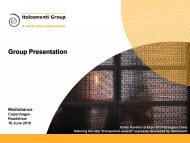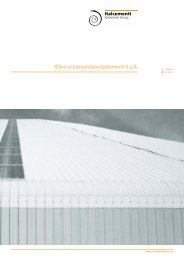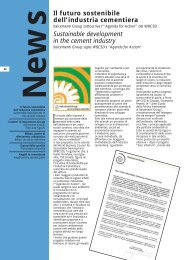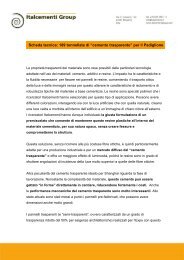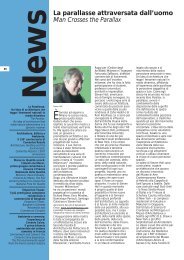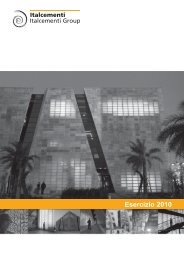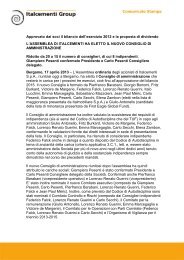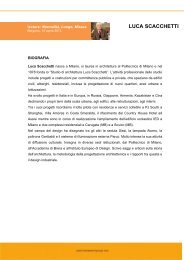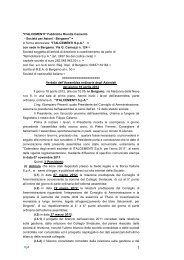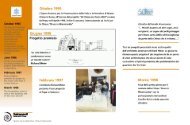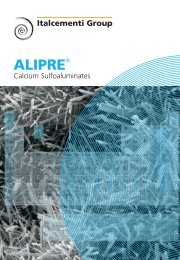2012 Annual Report - Italcementi Group
2012 Annual Report - Italcementi Group
2012 Annual Report - Italcementi Group
You also want an ePaper? Increase the reach of your titles
YUMPU automatically turns print PDFs into web optimized ePapers that Google loves.
SDD011<br />
ISO 14001<br />
<strong>Report</strong>ing<br />
Instruction<br />
SDD012<br />
Raw Materials<br />
<strong>Report</strong>ing<br />
Instruction<br />
SDD013<br />
Fuels <strong>Report</strong>ing<br />
Instruction<br />
SDD016<br />
Quarry<br />
rehabilitation<br />
Instruction<br />
N4<br />
<strong>Group</strong> Innovation<br />
Safety<br />
management<br />
handbook<br />
SDD017<br />
Industrial Hygiene<br />
–<br />
Workplace<br />
Assessment<br />
Human resources<br />
database<br />
Human resources<br />
database<br />
Percentage of sites certified ISO 14001<br />
Total RMs and ARMs consumption for cement<br />
production<br />
Total fuels and AFs consumption for clinker<br />
production<br />
Percentage of quarries with a rehabilitation plan<br />
and included or nearby protected zones for<br />
nature preservation<br />
Percentage of turnover from innovative<br />
products<br />
LTI Frequency Rate<br />
Percentage of employees potentially exposed<br />
to dust, silica, noise and vibration covered by<br />
the workplace assessment<br />
Total of employees (gender, age and<br />
geographical distribution)<br />
Hiring and dismissals<br />
The ISO 14001 certified facilities are cement plants, grinding centers, aggregates<br />
quarries and plants, ready-mix concrete plants which have developed and<br />
implemented Environmental Management Systems complying with the<br />
requirements set in the standard ISO 14001:2004, certified by qualified bodies<br />
and with valid certificates.<br />
The instruction defines natural and alternative raw materials (ARMs). The <strong>Group</strong><br />
Technical Center draws the data from the <strong>Group</strong> database; figures are endorsed<br />
by the subsidiaries before being forwarded to SDD. Dry tonnes of RMs and<br />
ARMs are reported according to “CSI Guidelines for the selection and use of<br />
fuels and raw materials in the cement manufacturing process”.<br />
The instruction defines conventional and alternative fuels (AFs). The <strong>Group</strong><br />
Technical Center draws the data from the <strong>Group</strong> database; figures are endorsed<br />
by the subsidiaries before being forwarded to SDD. Thermal input from<br />
conventional fuels and AFs reported according to “CSI Guidelines for the<br />
selection and use of fuels and raw materials in the cement manufacturing<br />
process”.<br />
The procedure sets that employees potentially exposed to dust, silica, noise and<br />
vibration have to be evaluated versus international standards recommended in<br />
the procedure. When defining the number of potentially exposed employees only,<br />
default values may be are used to correct incomplete reporting from countries.<br />
Monitoring activity is always supported by evidence.<br />
The innovation rate is the ratio between the operational turnover realized with the<br />
sales of innovative products and the total operational turnover. Innovation<br />
Projects are identified as New Products (cements and binders, ready mix<br />
concretes, admixtures, mortars and others); New Applications (new construction<br />
solutions even with existing products); New Services pertaining to the area of<br />
sustainable development, distribution and packaging; New Manufacturing<br />
Processes represented by specific manufacturing processes made available to<br />
the market after an internal development of specific know-how and patents.<br />
Innovation projects are classified according to three categories: Established<br />
(Product-Application-Service-Manufacturing process already present both in the<br />
reference market of the Subsidiary and in the Subsidiary offer); Incremental<br />
(Product-Application-Service-Manufacturing process present in the reference<br />
market of the Subsidiary but not in the Subsidiary offer); Radical (Product-<br />
Application-Service-Manufacturing process new to the reference market of the<br />
Subsidiary and to the Subsidiary offer). According to the novelty condition,<br />
the innovation period can vary from a minimum of 3 years to a maximum of 9<br />
years. The innovation rate includes admixtures with no limit of duration<br />
because of the permanent adaptation of the product. It also includes the<br />
cement in case of common sales of admixtures and cement to third parties.<br />
Existing products which have been repositioned because of their contribution<br />
to sustainable development are included in the innovation rate as well.<br />
A <strong>Group</strong> database, automatically updated at site level, calculates lost time<br />
injuries (days) in a year per million hours worked, according to WBCSD/CSI<br />
definitions.<br />
The procedure sets that employees potentially exposed to dust, silica, noise and<br />
vibration have to be evaluated versus international standards recommended in<br />
the procedure. When defining the number of potentially exposed employees only,<br />
default values may be are used to correct incomplete reporting from countries.<br />
Monitoring activity is always supported by evidence.<br />
Human resources database based on SAP system and collecting gender,<br />
age and geographical information about employees.<br />
Human resources database based on SAP system and collecting entries and<br />
leaves, categorized by type, within the <strong>Group</strong> perimeter or reassignments<br />
between different subsidiaries.<br />
<br />
348



